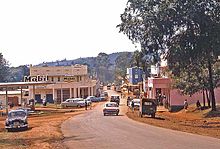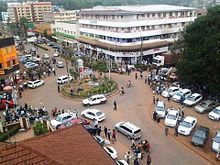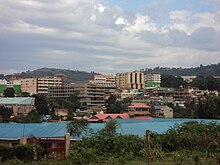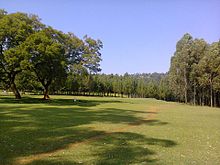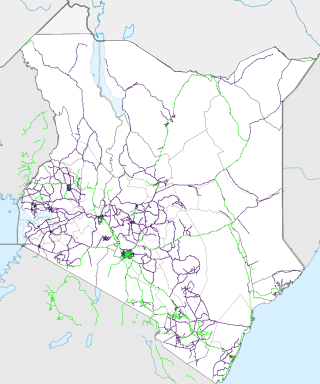
Transport in Kenya refers to the transportation structure in Kenya. The country has an extensive network of paved and unpaved roads.

Kisumu is the third-largest city in Kenya after the capital, Nairobi, and Mombasa. It is the second-largest city after Kampala in the Lake Victoria Basin. The city has a population of slightly over 600,000. The metro region, including Maseno and Ahero, has a population of 1,155,574 people according to the 2019 Kenya Population and Housing Census which was conducted by the Kenya National Bureau of Statistics.

The Abagusii are a Bantu ethnic group and nation indigenous to Kisii and Nyamira counties of former Nyanza, as well as parts of Kericho and Bomet counties of the former Rift Valley province of Kenya.
The Gusii language is a Bantu language spoken in Kisii and Nyamira counties in Nyanza Kenya, whose headquarters is Kisii Town,. It is spoken natively by 2.2 million people, mostly among the Abagusii. Ekegusii has only two dialects: The Rogoro and Maate dialects. Phonologically, they differ in the articulation of /t/. Most of the variations existing between the two dialects are lexical. The two dialects can refer to the same object or thing using different terms. An example of this is the word for cat. While one dialect calls a cat ekemoni, the other calls it ekebusi. Another illustrating example can be found in the word for sandals. While the Rogoro word for sandals is chidiripasi, the Maate dialect word is chitaratara. Many more lexical differences manifest in the language. The Maate dialect is spoken in Tabaka and Bogirango. Most of the other regions use the Rogoro dialect, which is also the standard dialect of Ekegusii.

Narok County is a county in southwestern Kenya with an estimated population of 1,157,873 according to 2019 Census. The dominant ethnic group is the Maasai. Its capital and largest town is Narok, with the only other major urban centre being Kilgoris. Narok County Government was formed by the County Governments Act of 2012 as prescribed in the 2010 Constitution of Kenya. Narok County governor is Patrick Ole Ntutu after winning in the 2022 elections and his Deputy is Tamalinye K. Koech.

Nyamira County is a county in the former Nyanza Province of Kenya. Formally a district, Nyamira was hived off Kisii District in 1989, and it shares common boundaries with what was known as Nyamira District. The main cash crops grown are bananas and tea. The county has a population of 605,576. Its capital and largest town is Nyamira, with an urban population of around 41,668 The county is also referred to as North Kisii.

Local authorities in Kenya are the bodies controlling local governance in urban areas in Kenya.
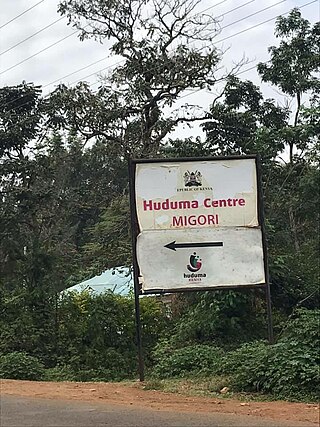
Migori county 044, also known as Suna-Migori, is a multi-ethnic municipal town which acts as the capital of Migori County, Kenya. The town is located 63 kilometers south of Kisii town and 22 km north of the Tanzanian border. The Migori Metropolitan area consists of Migori municipality and the adjacent smaller towns. The area has three constituencies, namely Suna East, Suna West and Uriri, with a total population of 393,012 according to the Kenya National Bureau of Statistics-sponsored national census of 2019. The neighboring town/constituency of Awendo has 96,872 and Kuria East (Sirare) has 117, 290. In 2010, The Star newspaper reported that the town (proper) had a population of approximately 100,000 people.

Migori County is a county in the former Nyanza Province of southwestern Kenya. It borders Homa Bay County to the north, Kisii County to the northeast, Narok County to the southeast, Tanzania to the west and south, and Lake Victoria to the west. The county also borders Uganda via Migingo Island in Lake Victoria. The county is headquartered by Migori, which is also its largest town. At the 2019 census, Migori County had a population of 1,116,436, almost 200,000 more than the 917,170 recorded in 2009.
Oyugis is the second-largest town in Homa Bay County in Nyanza Kenya. The town lies along the Kisumu-Kisii highway. It is the commercial and financial centre of Rachuonyo Sub-County in Homa Bay County of the former Nyanza Province.

Kisii County is a county in the former Nyanza Province in southwestern Kenya. Its capital and largest town is Kisii. The county has a population of 1,266,860 people. It borders Nyamira County to the North East, Narok County to the South, and Homa bay and Migori Counties to the West. The county covers an area of 1,318 km².
Magwagwa is a small town in Nyamusi division, Nyamira County in Kenya.
Kisii Airport is an airport in Kisii County, Kenya.

Sub-counties, also known as Districts, are the decentralised units through which government of Kenya provides functions and services. At national level, sub-counties take a more administrative function like security, statistical purposes, provision of government services, etc. Even though the sub-counties are divisions of counties, powers to create new national sub-counties lies with the national government. As of 2023, there are 314 sub-counties, compared to 290 constituencies. A deputy county commissioner is appointed by the state to lead each sub-county. The sub-counties are further divided into divisions, locations and sub-locations.
Kisii University is a public university located in Kisii. It was founded in 1965 as a primary teachers’ training college on a 61-acre land that was donated by the County Council of Gusii. The college continued up to 1983 when it was upgraded to a secondary teachers’ college to offer Diploma programmes.
Kisii District was a district in the Nyanza Province in southwestern Kenya. Its capital town was Kisii. The district was created during the colonial period from the South Kavirondo District. The district is inhabited mostly by the Gusii people. Nyamira District was later carved out of Kisii in 1989. Further splitting led to the creation of Kisii Central District and Gucha District. In 2013, the district's former boundaries, except Nyamira District, were effected again to form Kisii County.
Mwalimu Cooperative Savings and Credit Society Limited, also known as Mwalimu National Sacco Limited, but often referred to as Mwalimu Sacco, is a savings and credit co-operative society (Sacco) in Kenya, the largest economy in the East African Community. It is an institutional Sacco, composed of the staff of the Teachers Service Commission (TSC), TSC teachers in secondary and tertiary institutions, TSC teachers in elementary schools, the staff of Mwalimu National Sacco Limited and the spouses of the above members, when formally gainfully employed. The society is licensed and regulated by the Sacco Societies Regulatory Authority.
The Isebania–Kisii–Ahero Road is a road section of the A1 road in Kenya, connecting the towns of Isebania, Migori, Kisii and Ahero.
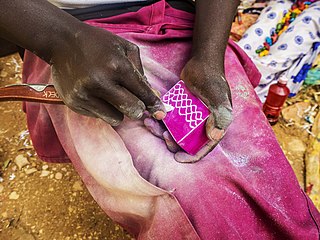
In the Kisii region in Kenya, soapstone is mined in the town of Tabaka. It has been at the heart of industry and culture, with its malleability allowing for the carving of a variety of items ranging from common household items to ornaments and other décor items, all of which have found their way into the commercial space, birthing the aforementioned 'industry' around the mining and processing of the ore – largely centered in Tabaka. In its finely milled form, soapstone has been found to have various commercial uses outside carving.



